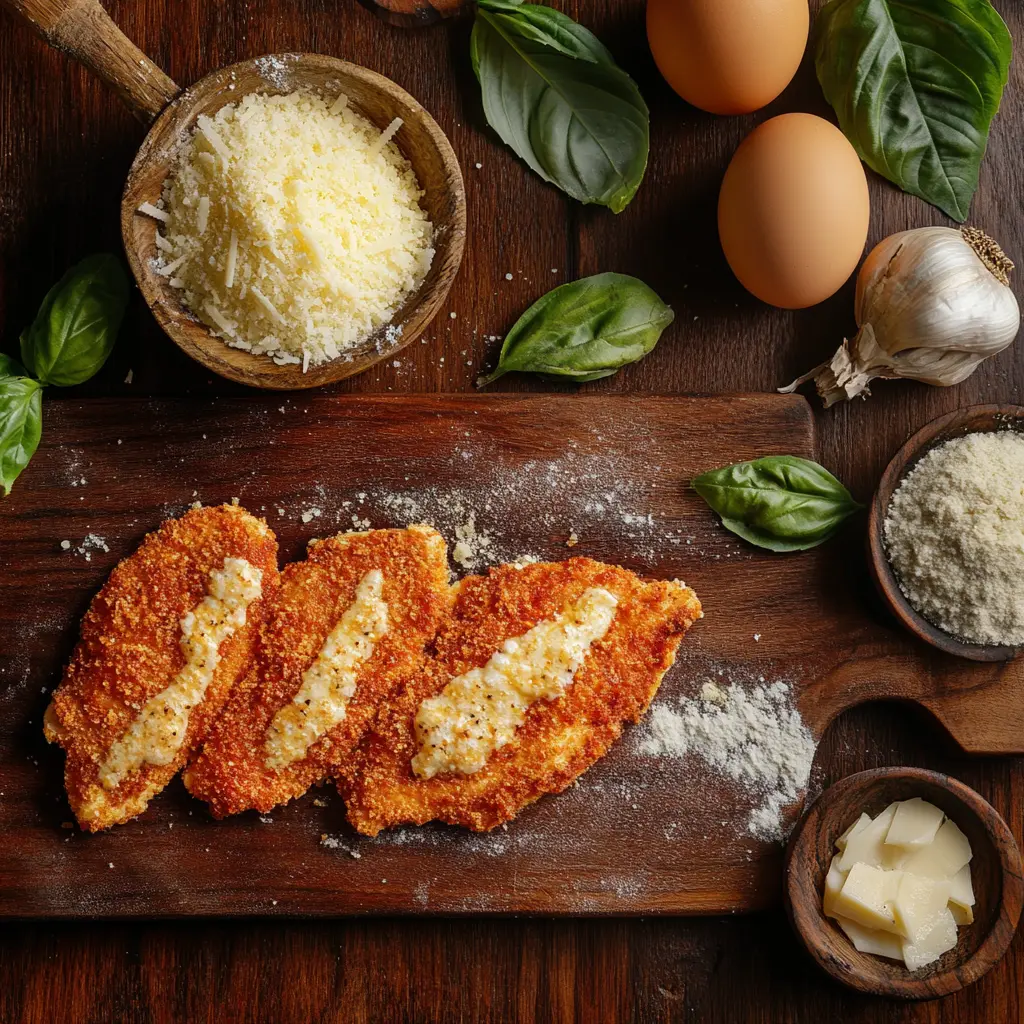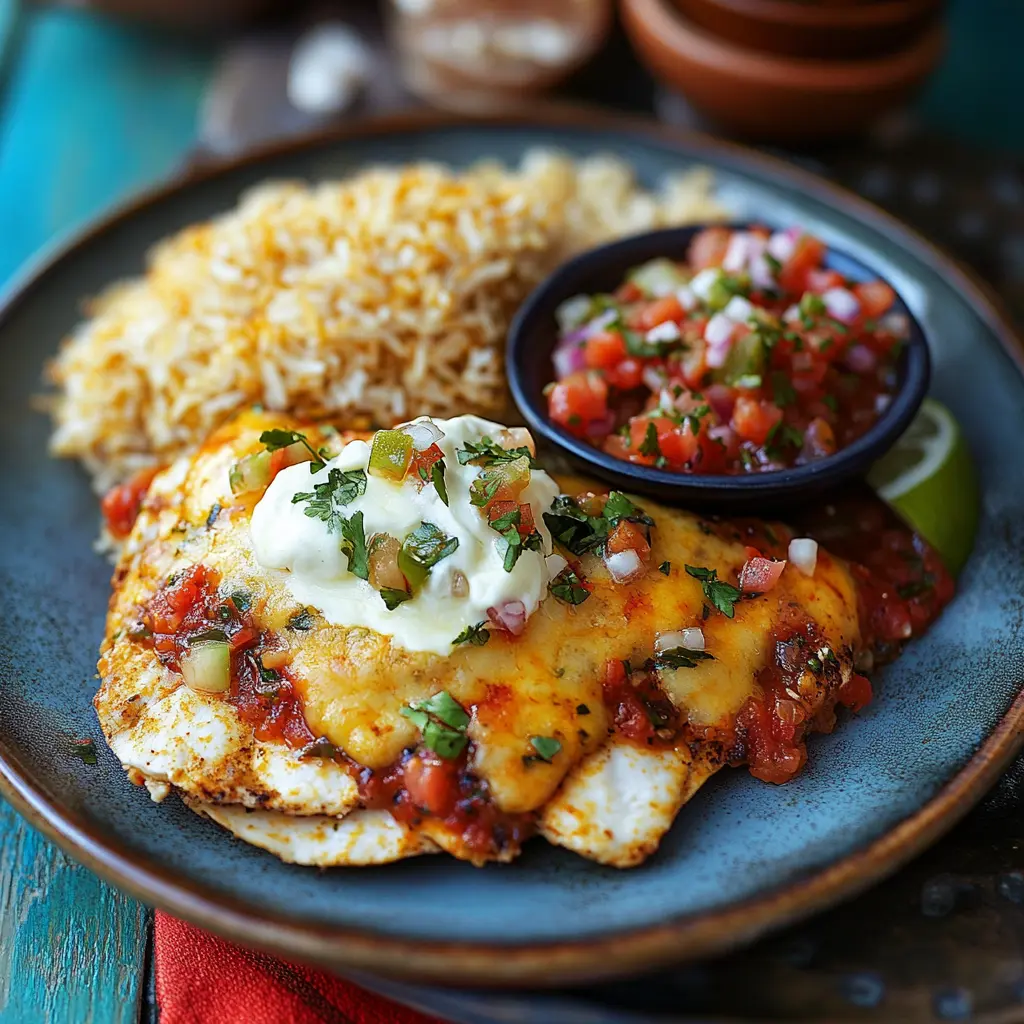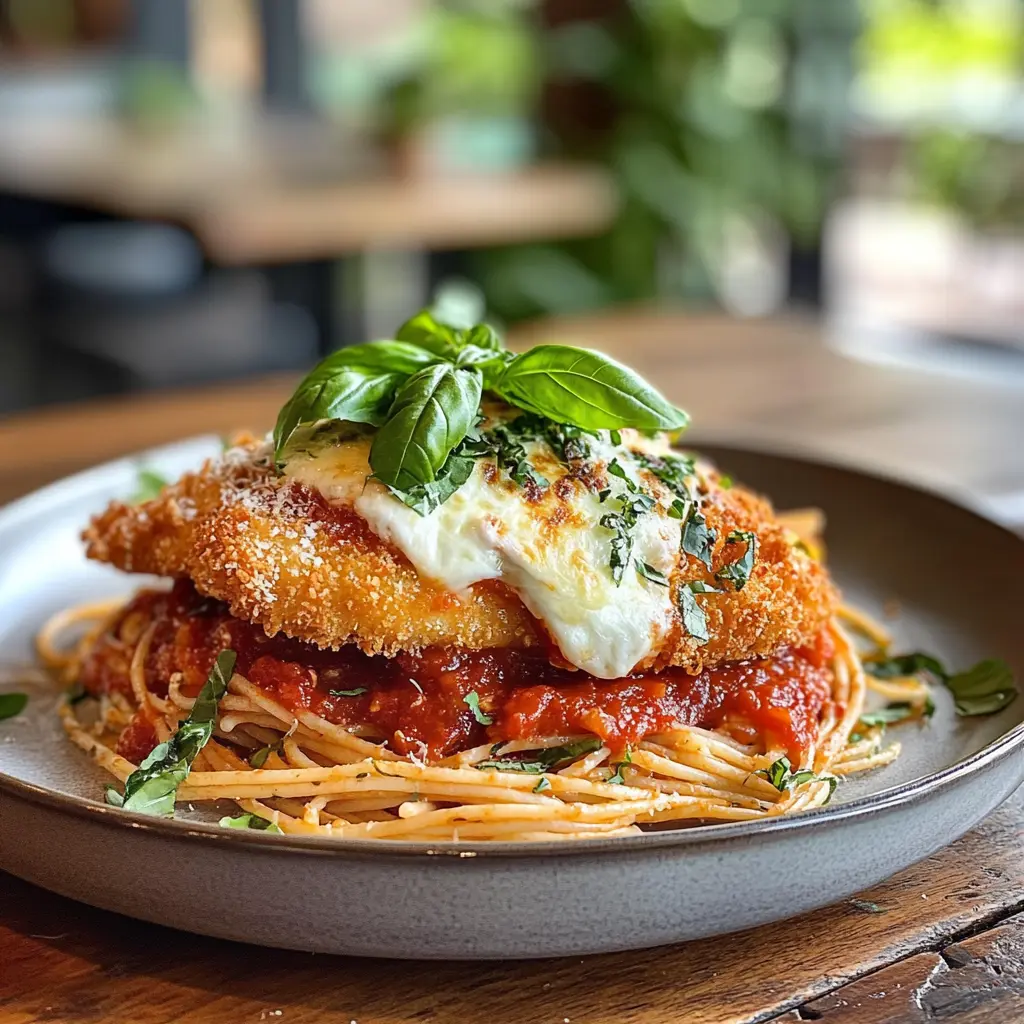Introduction
Chicken Parmesan, often hailed as a quintessential Italian-American dish, is a beloved recipe cherished for its crispy breaded chicken, rich marinara sauce, and melted mozzarella. This article dives deep into the world of chicken parmesan, from its origins to its modern adaptations, giving you the ultimate guide to preparing and enjoying this iconic dish. Whether you’re a seasoned chef or a home cook, there’s something here for everyone. Let’s explore, step by step, what makes chicken parmesan such a crowd-pleaser.
Part 1: History and Origin of Chicken Parmesan
The journey of chicken parmesan is as flavorful as the dish itself. Though it’s now an iconic staple in Italian-American kitchens, its story begins far from America, rooted in the rustic traditions of Southern Italy. Originally, Italians enjoyed melanzane alla parmigiana (eggplant parmesan), a dish featuring breaded and fried slices of eggplant layered with marinara sauce and cheese. This recipe eventually crossed oceans, transforming into something new and exciting.
From Eggplant to Chicken
When Italian immigrants brought their culinary traditions to America in the late 19th century, they often had to adapt to their surroundings. While eggplants were less common in their new homeland, chicken was abundant, affordable, and widely favored. Swapping eggplant for chicken added protein and heartiness to the dish, appealing to the American palate and creating a hybrid recipe that took the best of both worlds.
A Classic with American Flair
In its Italian roots, parmesan dishes were often simple and vegetable-forward. However, as chicken parmesan gained traction in America, it became a canvas for bold flavors. Rich tomato sauces, gooey mozzarella, and crispy breaded cutlets turned the dish into a showstopper. Served over pasta or tucked into a sandwich, it became synonymous with comfort food.
Why the Name “Parmesan”?
The “parmesan” in chicken parmesan isn’t just about the cheese. It’s a nod to the Parmigiano-Reggiano region in Italy, where one of the world’s finest cheeses originated. While mozzarella often takes center stage in modern recipes, the name connects the dish to its Italian heritage, honoring its place in culinary history.
Part 2: Traditional Ingredients Used in Chicken Parmesan
The magic of chicken parmesan lies in its ingredients. Each component plays a crucial role in creating the perfect balance of textures and flavors. By carefully choosing and preparing these ingredients, you can elevate this classic dish into something truly extraordinary.
The Star Ingredient: Chicken Breast
The foundation of chicken parmesan is the chicken itself, and boneless, skinless chicken breasts are the go-to choice. Their mild flavor and lean meat make them ideal for soaking up the rich marinara sauce and gooey cheese. When properly prepared, chicken breasts become tender and juicy, providing a satisfying contrast to the crispy breading.
For an even thickness, it’s common to pound the chicken breast with a meat mallet. This ensures the meat cooks evenly, preventing dryness while maintaining that delightful crunch on the outside. Some chefs opt for chicken thighs for a more robust flavor, but the chicken breast remains the gold standard.
The Perfect Breading: Flour, Eggs, and Breadcrumbs
The breading is where the magic begins. This step gives chicken parmesan its signature golden crust. The process typically involves three layers:
- Flour: Lightly dusting the chicken with flour ensures that the egg wash adheres to the surface.
- Eggs: A whisked egg mixture acts as the glue, binding the breadcrumbs to the chicken.
- Breadcrumbs: The final coating, made from seasoned breadcrumbs, creates that iconic crispy texture.
While traditional recipes rely on plain breadcrumbs, many cooks experiment with panko for an extra-crispy finish. Some also add grated Parmesan cheese or Italian seasoning to the breadcrumb mix for added flavor.
The Essential Marinara Sauce
Marinara sauce is the heart of chicken parmesan. Its tangy, savory flavor complements the richness of the cheese and chicken. Authentic marinara is made with simple, fresh ingredients, including tomatoes, garlic, olive oil, and herbs like basil and oregano.
Homemade marinara is often preferred for its vibrant flavor, but store-bought options can also work well in a pinch. Look for sauces with minimal added sugar and preservatives to maintain the dish’s authentic taste. A good marinara brings brightness and acidity, cutting through the richness of the other components.
Cheese: Mozzarella and Parmesan
Cheese is non-negotiable in chicken parmesan. While there are variations, mozzarella and Parmesan are the undisputed stars:
- Mozzarella: Known for its mild flavor and excellent melting properties, mozzarella creates that irresistible gooey layer on top. Fresh mozzarella, though slightly more delicate, offers an elevated experience with its creamy texture.
- Parmesan: Grated Parmesan adds a sharp, nutty flavor, enhancing the overall depth of the dish. It’s often sprinkled over the mozzarella before baking, creating a golden, bubbly topping.
Some recipes also incorporate provolone or a mix of Italian cheeses for added complexity, but mozzarella and Parmesan remain the classics.
Seasonings and Spices
The seasoning in chicken parmesan is simple yet effective. A touch of salt and pepper enhances the natural flavors of the chicken, while Italian seasoning or dried herbs like oregano and thyme bring an earthy warmth. Garlic powder is another common addition, infusing the breading with subtle aromatics.
Cooking Oil: The Key to Crispiness
Frying the breaded chicken to perfection requires the right oil. Neutral oils like vegetable, canola, or peanut oil work best because they withstand high temperatures without imparting strong flavors. The oil must be hot enough (around 350°F or 175°C) to quickly crisp up the breading without soaking it in grease.
For those seeking a healthier twist, baking or air-frying the chicken can still yield satisfying results, though it may lack the full crunch of traditional frying.
Pasta or Sides: The Supporting Cast
While not part of the chicken itself, the side dishes served with chicken parmesan play a big role in completing the meal. Spaghetti is the classic pairing, often tossed in a light marinara or olive oil to complement the flavors. Alternatives like zucchini noodles, mashed potatoes, or a fresh green salad are also popular choices.
Variations in Ingredients
Over the years, cooks have experimented with ingredient swaps to suit different tastes and dietary needs:
- Gluten-Free Chicken Parmesan: Replace traditional breadcrumbs with gluten-free panko or almond flour.
- Low-Carb Options: Use crushed pork rinds or grated Parmesan for breading.
- Vegan Chicken Parmesan: Substitute chicken with breaded eggplant, cauliflower, or plant-based alternatives like seitan or tofu.
Each variation stays true to the spirit of the dish while catering to specific preferences or restrictions.
The Importance of Fresh Ingredients
Whether you stick to the classic recipe or try a variation, the key to a great chicken parmesan lies in the freshness of the ingredients. Fresh herbs, high-quality cheese, and ripe tomatoes make all the difference. The harmony of these elements is what transforms simple components into an unforgettable dish.
Part 3: Step-by-Step Preparation of Classic Chicken Parmesan
Making chicken parmesan at home may seem daunting, but it’s surprisingly simple once you break it down into steps. By following this methodical process, you can achieve a perfectly crispy, flavorful, and tender dish that rivals any restaurant version.

Preparing the Chicken
Start by selecting boneless, skinless chicken breasts. If the chicken pieces are thick, slice them in half horizontally to create thinner cutlets. This helps the meat cook evenly and reduces the risk of the exterior overcooking before the inside is done. Place the cutlets between two sheets of plastic wrap or parchment paper and gently pound them with a meat mallet until they’re about ½-inch thick. Thinner cutlets ensure a tender bite and allow the breading to shine.
Seasoning the Chicken
Season both sides of the chicken cutlets with salt, pepper, and a sprinkle of garlic powder. This simple step enhances the flavor of the chicken, setting a solid base for the layers of breading, sauce, and cheese.
Breading the Chicken
The breading process involves three key steps:
- Flour: Dredge each chicken cutlet in all-purpose flour, shaking off any excess. The flour creates a dry surface, helping the egg mixture adhere to the chicken.
- Egg Wash: Beat a few eggs in a shallow bowl. Dip each floured cutlet into the egg wash, ensuring it’s fully coated.
- Breadcrumbs: Finally, press the chicken into a mixture of seasoned breadcrumbs. For added crunch and flavor, mix in grated Parmesan cheese and Italian seasoning.
Frying the Cutlets
Heat a generous amount of neutral oil, such as vegetable or canola oil, in a large skillet over medium-high heat. The oil should be hot enough to sizzle when you add the chicken but not so hot that it burns the breading. Fry the breaded chicken cutlets for 3–4 minutes on each side, or until they’re golden brown and crispy. Transfer the cooked cutlets to a paper towel-lined plate to drain excess oil.
Preparing the Marinara Sauce
While the chicken rests, prepare your marinara sauce. If you’re using store-bought marinara, pour it into a saucepan and warm it over low heat. For a homemade option, sauté minced garlic in olive oil, add crushed tomatoes, and season with salt, pepper, and fresh basil. Let the sauce simmer for 10–15 minutes to develop a rich flavor.
Assembling the Dish
Once the components are ready, it’s time to assemble the chicken parmesan. Preheat your oven to 400°F (200°C). Spread a thin layer of marinara sauce over the bottom of a baking dish. Arrange the fried chicken cutlets on top, spoon more marinara over each piece, and layer with sliced or shredded mozzarella cheese. Sprinkle grated Parmesan over the mozzarella for extra flavor.
Baking the Chicken Parmesan
Bake the assembled dish in the preheated oven for 10–15 minutes, or until the cheese is melted and bubbly with golden-brown spots. This final step brings all the elements together, allowing the flavors to meld into a harmonious dish.
Serving Your Chicken Parmesan
Serve your freshly baked chicken parmesan with spaghetti tossed in marinara sauce, a crisp green salad, or roasted vegetables. Garnish with fresh basil leaves or a light sprinkle of Parmesan cheese for a finishing touch.
Part 4: Variations of Chicken Parmesan Across Different Cultures
While chicken parmesan is rooted in Italian-American cuisine, its popularity has inspired countless variations around the world. From lighter twists to bold cultural fusions, these adaptations showcase the versatility of this beloved dish. Let’s explore some of the most creative and delicious interpretations.

Italian Roots: Eggplant Parmesan and Beyond
Before there was chicken parmesan, there was melanzane alla parmigiana (eggplant parmesan). This vegetarian classic features breaded and fried eggplant slices layered with marinara sauce and cheese. It remains a staple in Italy and is often served as a main course or side dish. For a closer tie to its origins, some recipes mix eggplant with chicken, creating a hybrid dish that honors both traditions.
American Comfort Food Spin
In the United States, chicken parmesan has evolved into a comfort food favorite. Variations include baked casseroles, sandwiches, and even pizza-inspired creations. The casserole version layers breaded chicken with marinara, cheese, and pasta, making it a one-dish meal perfect for family dinners. The sandwich form tucks crispy chicken and melted cheese into a toasted bun, ideal for quick, hearty meals.
Global Twists on Chicken Parmesan
Around the globe, chefs have reimagined chicken parmesan by infusing it with local flavors and ingredients:
- Asian Fusion: In Japan, the concept of breaded cutlets pairs seamlessly with tonkatsu sauce, a sweet and tangy counterpart to marinara. Some recipes swap the marinara for miso-based sauces or soy glaze, giving the dish a bold, umami-rich profile.
- Mexican-Inspired: A Mexican twist on chicken parmesan might use salsa or enchilada sauce in place of marinara, with a layer of melted queso fresco or Oaxaca cheese. Served with rice and beans, this variation is bursting with vibrant flavors.
- Middle Eastern Influence: In this take, the breading incorporates za’atar spices, and the marinara is replaced with a spiced tomato-based sauce. Adding a dollop of labneh (strained yogurt) on top balances the dish with a creamy tang.
Dietary Alternatives
For those with specific dietary needs, chicken parmesan offers plenty of room for customization:
- Gluten-Free: Use almond flour or gluten-free breadcrumbs for the breading.
- Vegan: Swap chicken for breaded tofu, eggplant, or cauliflower, and use plant-based cheese and sauce.
These creative twists ensure that chicken parmesan remains a versatile, crowd-pleasing dish for every palate. In the next section, we’ll delve into the nutritional aspects and health considerations of this dish.
Frequently Asked Questions (FAQs) About Chicken Parmesan
What is chicken parmesan made of?
Chicken parmesan is made from breaded and fried chicken cutlets topped with marinara sauce, mozzarella cheese, and Parmesan cheese. It’s typically baked until the cheese is melted and bubbly, then served with pasta, salad, or other sides.
What’s the difference between chicken parmesan and chicken parmigiana?
There’s no difference! The terms are used interchangeably. “Chicken parmigiana” reflects the Italian roots of the dish, while “chicken parmesan” is the anglicized version popular in the U.S.
How do you keep the breading crispy in chicken parmesan?
To keep the breading crispy, make sure to fry the chicken cutlets at the right temperature (around 350°F) and avoid overloading the pan. After frying, drain the cutlets on paper towels to remove excess oil. When assembling, don’t oversaturate the chicken with marinara sauce.
Can chicken parmesan be made ahead of time?
Yes, you can prepare the components in advance. Bread and fry the chicken cutlets, store them in an airtight container in the fridge, and reheat before assembling. Marinara sauce can also be made ahead. Assemble and bake just before serving for the best results.
What can I serve with chicken parmesan?
Chicken parmesan pairs well with spaghetti, garlic bread, roasted vegetables, or a fresh green salad. For lighter options, consider zucchini noodles or a side of steamed broccoli.
Is chicken parmesan healthy?
The healthiness of chicken parmesan depends on how it’s prepared. Traditional methods involving frying and cheese make it indulgent, but healthier options include baking the chicken, using low-fat cheese, or choosing whole-grain pasta as a side.
In the next part, we’ll conclude the article with key takeaways and additional tips to make the best chicken parmesan.
Conclusion
Chicken parmesan is more than just a delicious meal; it’s a timeless classic that embodies the perfect fusion of flavor, texture, and cultural heritage. From its humble Italian beginnings to its transformation into an iconic Italian-American dish, it has captured hearts and taste buds worldwide. Whether you stick to traditional methods or experiment with creative variations, the dish offers endless opportunities for personalization.
With the right ingredients, careful preparation, and a little practice, you can make restaurant-quality chicken parmesan at home. Remember to use fresh, high-quality components, season generously, and balance the rich layers of breaded chicken, marinara, and cheese for a dish that delights every time.
No matter how you choose to serve it—alongside pasta, a crisp salad, or a vegetable medley—chicken parmesan is sure to bring comfort and joy to your table. So go ahead, try your hand at this classic recipe, and create a masterpiece that’s as satisfying to make as it is to eat!

